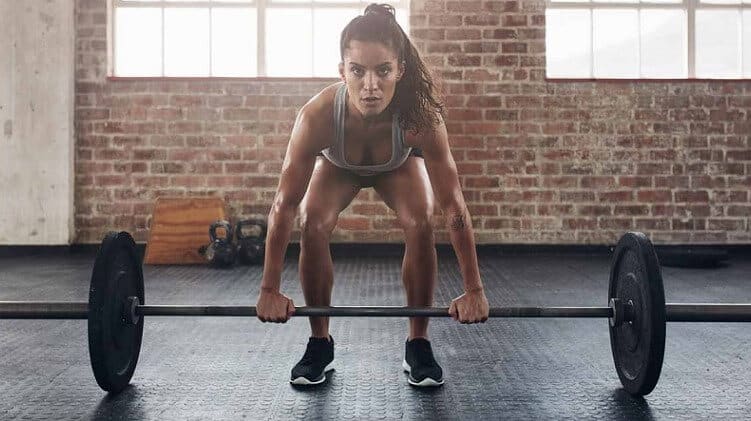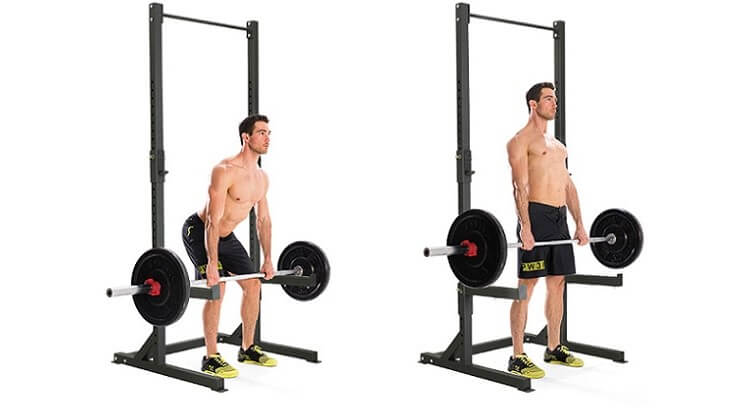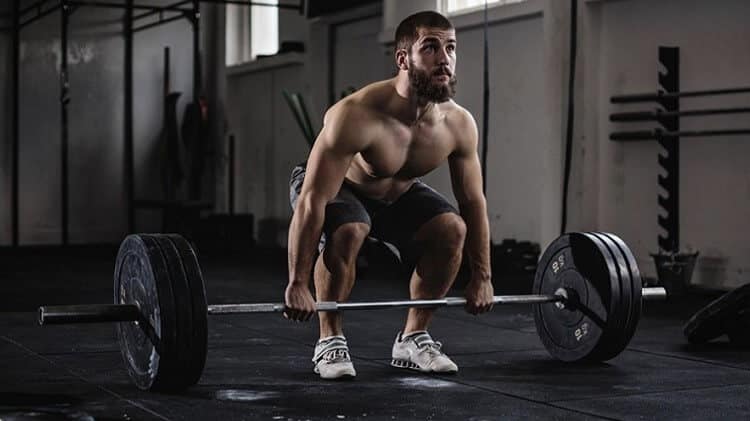Deadlifts are arguably one of the most popular exercises amongst bodybuilders engaged in one form of weight training program or another.
As a workout routine, the deadlift exercise is also one of the simplest workouts to execute and can be performed by all levels of bodybuilders including beginners, intermediate, and advanced bodybuilders.
Simply put, in a deadlift you get to lift up a weight from a position of rest either on the floor, a rack or machine for a certain number of times or repetitions.
While a deadlift workout is simple enough, its effect on the body is not so simple. Deadlifts typically train multiple skeletal muscle groups at the same time, including the muscles of the thighs, hips, and back.
There are quite a few variations of the deadlift workout, but one thing that they all share in common is technique. You need to master the technique of executing whatever variation of deadlift you intend performing at home or in your local gym.
Without proper form and technique, you could be at risk of sustaining avoidable injuries, so in this article, you will get to know the right technique to perform a deadlift.
You will also get to know the muscle groups that deadlifts train as well as some of the popular deadlift variations you could try out. We then end this post with some useful tips for executing a perfect deadlift that lowers your risk of incurring injuries.
Mastering Proper Deadlift Technique in Five Steps
Here are five (5) key steps to take in executing a deadlift while keeping proper form and applying the right technique for a successful workout.
However, note that the steps highlighted below apply to a conventional deadlift exercise and there may be variations that you may have to make depending on the demands of the variation of deadlift you intend performing.
Step #1: Perfecting Feet Stance
You begin your deadlift by positioning your feet. Typically, your feet stance for a conventional deadlift should be a shoulder width apart. This feet stance may be different for other variations of deadlifts.
You should also ensure that your shins are as close to the EZ-bar or barbell as possible while your feet are placed just under the EZ-bar or barbell.

Step #2: Mastering Torso Position
To begin with a lift after getting your feet stance correct, you need to lower your torso towards the EZ-bar or barbell.
To do this, you need to push back your buttocks with your hips and waist acting like a hinge or pivot. In this position, grab hold of the EZ-bar or barbell with your hands.
Step #3: Engage your Core
You then need to engage your core by ensuring that your neck and head are in a neutral position while your hips are lower than your shoulders.
By squeezing your shoulder blades inwards, you will also engage your lats.
Step #4: Lifting Weight by Pushing through your Feet
To lift the weight on your EZ-bar or barbell, you need to push through your feet almost as if you want to push the ground away with your feet.
In effect, you are not trying to lift the weight upwards using your arms, but instead you will use the power of your feet while leveraging on your hips as a pivot in lifting the weight.
Remember to keep the EZ-bar or barbell close to your shins as you squeeze your glutes in order to lock the peak of the lift.
Step #5: Lower Weight and Repeat Technique
Once you have successfully accomplished a deadlift, you then need to lower the weight to the floor by shooting out your buttocks while using your hips as a hinge and maintaining a neutral neck and back position in the process.
Skeletal Muscles Activated during a Deadlift
You can rightly refer to a deadlift exercise as a full body workout simply because you will activate multiple skeletal muscle groups of both your lower and upper body.
As a matter of fact, during a deadlift, you will activate your erector spinae, quadriceps, gluteus maximus, biceps femoris, and semitendinosus (hamstrings) amongst many other muscle groups.
In summary, whenever you execute a deadlift using perfect form and technique, you tend to train the following muscle groups in addition the those already mentioned.Adductor Magnus,
- Obliques and Abdominals
- Latissimus Dorsi,
- Rhomboids and
- Trapezius.
Five (5) Deadlift Variations to Try Out
There are many deadlift variations to try out. Eachnone of the variations available is designed to help you achieve a particular training goal.
Variations also exist to meet the peculiar training limitations of individuals and also to help enhance performance in particular sporting engagements.
Here are five (5) deadlift variations that are just as popular as conventional deadlifts.
#1. Rack Deadlifts
With a Rack Deadlift you can assume whatever foot stance you are comfortable with. However, the position of the barbell or EZ-bar on the rack should be at a height that you are again comfortable with.
The Rack Deadlift enables you to lift heavy or to train specific muscle groups you identify as weak.

#2. Romanian Deadlift (RDL)
With a Romanian Deadlift (RDL) you assume a feet stance with your feet spread a shoulder width apart. However, your knees will be flexed outwards at about a 15 degree angle.
Keep your torso neutral while effecting a downward movement for a lift by flexing your hips posteriorly.
With this deadlift, the primary focus are the muscles of your hamstrings, glutes, and lower back.
#3. Snatch Grip Deadlift
In a Snatch Grip deadlift,you maintain the feet stance of a Conventional Deadlift with your feet spread a shoulder width apart.
However, rather than grabbing hold of the EZ-bar or barbell with a hand position that is just outside your thighs, as is the case with a Conventional Deadlift, with a Snatch Grip Deadlift, you make use of a grip that is much wider in comparison.
By using a wider grip, you will ensure the stabilization of the muscle groups of your upper back and scapula.
#4. Straight or Stiff Leg Deadlift
With this deadlift, you assume a feet stance similar to a Conventional Deadlift with your feet spread about a shoulder width apart.
However, make sure that your knees are extended rather than being fully locked out.
Next, your torso assumes a neutral posture while the downward movement for a lift is instigated by your hips which move and are flexed posteriorly.
In the Stiff Leg Deadlift, the primary focus is on your hamstrings and lower back.
#5. Sumo Deadlift
In a Sumo Deadlift you assume a much wider feet stance in comparison to a Conventional Deadlift feet stance.
Your arms will be positioned inside your thighs while your torso maintains a firm upright posture to enable you to make more use of your hips and waist during a lift.
Benefits of Deadlifts
No matter what deadlift variation you prefer, you can expect to gain quite a number of physiological benefits.
Here is a list of the top Deadlift benefits;
- Deadlifts will help to train and activate your core.
- Deadlifts help to activate and train your hip extensors.
- Deadlifts can greatly minimize lower back pain.
- Deadlifts are known to greatly enhance jump performance.
- Deadlifts can boost bone density.
- eadlifts are known to boost metabolism making them great for anyone running a cutting program.

Five (5) Tips for Proper Form to Minimizing Injury during Deadlift
Tip #1:
Figure out your strongest possible feet stance by jumping up several times and landing on the floor to see where exactly your feet would land on each occasion.
Your strongest feet stance would be where your feet naturally land the most whenever you jump and land on the floor. Assume this feet stance for your deadlift.
Tip #2:
Make sure the EZ-bar or barbell is close enough to your body. You should make sure that the EZ-bar or barbell touches your shins when you are preparing for a deadlift. To avoid shin burns, you should wear long gym pants or high socks.
Tip #3:
Always assume proper form before any lift by ensuring that your spine is neutral, your knees are out and your chest is up. Avoid being hunched over while you prepare for a lift and make sure that you engage your lats with your knees facing outwards.
Tip #4:
Make sure you complete a deadlift using a hinging motion that starts from your hips. Avoid making a squatting motion when executing a deadlift.
Tip #5:
Make sure that you don’t hyperextend at the peak of your deadlift motion. You should engage your glutes when your deadlift peaks.
Conclusion
Deadlifts are a great exercise routine for anyone wishing to activate multiple muscle groups of the upper and lower body. There are many variations to choose from including Conventional Deadlift, Rack Deadlift, Snatch Grip Deadlift, Stiff Leg Deadlift, and Sumo Deadlifts.
You can mix-up your training regimen to include two or more variations depending on your training goals.
If you want more advice on how to go about a deadlift exercise, at Anabolic Coach, we offer free coaching at the hands of an IFBB PRO.
Don’t forget that proper form and technique during a deadlift will not only activate your muscle groups better, but will also save you from injuries, so always maintain good form whilst you perform a deadlift at home or in a gym.


